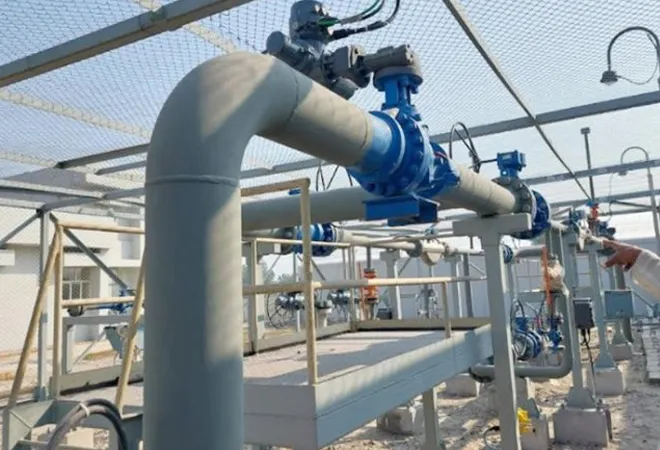
On 18 March 2023, a new page was added to the ‘Shonali Odhayay’ or the Golden Chapter in India-Bangladesh relations, as the Prime Ministers of both countries met over a virtual ceremony to inaugurate the
India-Bangladesh Friendship Pipeline (IBFP). The agenda of this collaboration is to supply high-speed diesel from the Numaligarh Refinery Limited in Assam, India, to
16 districts in the Rajshahi and Rangpur divisions of northern Bangladesh with the help of Bangladesh Petroleum Limited. The Numaligarh refinery has been supplying petroleum products to Bangladesh since 2015 and currently Bangladesh imports
60,000 to 80,000 metric tonnes of diesel from India via railway networks. The IBFP will reduce the transportation cost of each imported diesel barrel from the port cities of Chattogram and Mongla, from US$ 8 to US$ 5. It will also reduce the transportation time from several days to just one hour.
Map of India-Bangladesh Friendship Pipeline
 Source: Narendra Modi, YouTube
Source: Narendra Modi, YouTube
The cross-border pipeline is the first of its kind and runs from Siliguri in West Bengal, India to the oil depot in the Parbatipur upazila (sub-district) of the Dinajpur district in Bangladesh. Of its total length of roughly
132 kilometres (km), around 5 km is on Indian territory and the remaining 127 km lies within Bangladesh. The pipeline has a capacity of transferring 1 million metric tonnes of diesel per annum, but, initially, it will
supply Bangladesh with 2.5 lakh tonnes of diesel every year and then increase it to 4.5 lakh tonnes. The IBFP project began in September 2018 and was built with an Indian grant of INR
377 crores, equivalent to almost US$ 46 million. It is a feather in the cap of energy cooperation between the two countries, especially as it promises to abate the
energy crisis that Bangladesh has been facing since last year.
Energy crisis in Bangladesh
Bangladesh suffered
a national power grid failure in October 2022, which left almost 140 million people across the country without electricity. Although the exact cause of the failure was unknown, the blackout was a glaring example of the long and frequent load shedding that the country is facing including
10 hour-long nationwide power cuts. The power crisis has been attributed to the rising demand for and shortage of natural gas that the country uses to produce electricity. Almost 85 percent of the country’s electricity is produced using natural gas and oil.
Many reasons have been identified for this gas shortage, including
not using a state-owned company for the exploration of Bangladesh’s natural resources; making the country’s power production heavily and almost singularly
dependent on natural gas; rising prices of oil and gas due to the
Russia-Ukraine conflict;
soaring prices of Liquified Natural Gas imports, given its high demand in the European markets caused by the European Union’s embargo on Russian crude oil; and the
OPEC+ cuts on oil production. Amongst these factors, the inflation and complications in purchasing fuel have hit Bangladesh hard as the country imports nearly
77 percent of its total oil and refined fuels.
The negative growth in the RMG economy, the falling energy imports, rising fuel prices, and the daily struggle of living with long power cuts has also disgruntled the citizens of Bangladesh, spurring protests on the streets of Dhaka as well as on social media.
The power crisis in the country has heavily impacted the economy, especially as Bangladesh is focused on
rapid economic development to emerge as an upper middle-income country in the near future. The flag-bearer of Bangladesh’s flourishing economy, the Ready-Made Garment (RMG) industry, has been directly affected by the almost daily power cuts, which last for three hours on average. Consequently, many of the garment factories have experienced a
fall in production by almost 50 percent. Furthermore, with the unreliable power supply, the manufacturers have had to rely on expensive
diesel generators to keep their dyeing and washing units functional to prevent fabrics from being wasted. The cost of production has, thus, escalated while delays have affected the production process, further compelling manufacturers to choose costlier air shipments to make up for lost time. Naturally, the competitiveness of Bangladesh’s garment exports have reduced and the sector has recorded a
negative growth of 7.5 percent in September 2022 compared to September 2021. The negative growth in the RMG economy, the falling energy imports, rising fuel prices, and the daily struggle of living with long power cuts has also
disgruntled the citizens of Bangladesh, spurring
protests on the streets of Dhaka as well as on social media. The situation is unfavourable for the Awami League government, especially as it faces elections this year.
Impact on forthcoming elections
In the upcoming parliamentary ballots, Prime Minister Sheikh Hasina is relying heavily on the trump card of development to secure her win. The construction of the
Padma Multipurpose Road and Rail bridge, the
operationalisation of several connectivity projects with India, and a
100 percent electrification of Bangladesh are some of her major achievements. However, the growing power crisis, which undermines the country’s development, is now being added to the Opposition’s repertoire of accusations against the government. Accordingly, alongside protests against financial corruption and a lack of democratic freedoms, rising fuel prices and blackouts are now also a part of the agenda of the Bangladesh Nationalist Party’s campaign
rallies. Under such circumstances, the inauguration of the Friendship Pipeline will help add fresh vigour to the Awami League’s electoral campaign, as increased diesel supply will help diversify the country’s heavy reliance on natural gas for the production of electricity. Currently
, around 6–10 percent of Bangladesh’s electricity is produced with the help of diesel. Speaking at the inaugural ceremony of the pipeline, PM Hasina stated that, “
At a time when many countries are facing an energy crisis because of the Russia-Ukraine war, this pipeline will play a significant role in ensuring energy security for our people.” The Indian Prime Minister Narendra Modi added, “
Reliable and cost-effective diesel supply will be especially beneficial for the agriculture sector. Local industries will also benefit.”
Benefits for India
The pipeline has its benefits, both direct and indirect, for India. In the first instance, the pipeline would help in further increasing trade and cooperation between the two countries, especially via India’s Northeast, an area where both governments are eager to collaborate in. As Prime Minister Hasina stated, “
A good market has been created for Assam in Bangladesh... Assam’s residents will benefit.” Indirectly, given the excellent terms that India enjoys with the Bangladesh government, Prime Minister Hasina’s electoral win for another term would help both countries to progress further in the various areas of cooperation that they have jointly undertaken.
The India-Bangladesh Friendship Pipeline is a new milestone in this saga of bilateral cooperation, especially as it will be a sustainable, environment-friendly and yet cost-effective mode of transporting High Speed Diesel.
In the India-Bangladesh history of bilateral relations, cooperation in energy has witnessed major growth like the joint development of the
Maitree Thermal Power Plant with a capacity of
1,320 (660×2) MW, in Rampal, Khulna, Bangladesh and an enhanced coal supply from India for the power plant since 2021; Bangladesh allowing
transportation of Petroleum, Oil and Lubricants from Assam to Tripura via its territory; Bangladesh
enlisting Indian Oil Corporation Ltd. as a registered G2G supplier of refined petroleum products; and Bangladesh Power Development Board signing the Power Purchase Agreement with Adani Power Limited’s wholly-owned subsidiary Adani Power Jharkhand Limited (APJL), by which the latter will provide 1,496MW net capacity power to Bangladesh. Currently, the APJL unit at Godda, Jharkhand, India supplies
748MW of power to the neighbouring country, and the second 800MW thermal power plant, which is expected to be commissioned soon, will further enhance the power supply. The India-Bangladesh Friendship Pipeline is a new milestone in this saga of bilateral cooperation, especially as it will be a
sustainable, environment-friendly and yet cost-effective mode of transporting High Speed Diesel. Above all, by strengthening energy connectivity, the IBFP will help bring the people of the two countries closer together.
Sohini Bose is a Junior Fellow at the Strategic Studies Programme, Observer Research Foundation.
The views expressed above belong to the author(s). ORF research and analyses now available on Telegram! Click here to access our curated content — blogs, longforms and interviews.



 On 18 March 2023, a new page was added to the ‘Shonali Odhayay’ or the Golden Chapter in India-Bangladesh relations, as the Prime Ministers of both countries met over a virtual ceremony to inaugurate the
On 18 March 2023, a new page was added to the ‘Shonali Odhayay’ or the Golden Chapter in India-Bangladesh relations, as the Prime Ministers of both countries met over a virtual ceremony to inaugurate the 
 PREV
PREV


